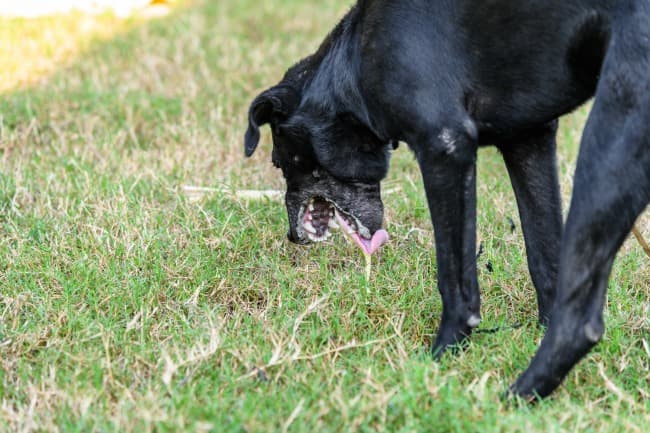FYI: If you buy something through a link on this site I may earn a commission - at NO extra cost to you.
About Dog Emergency Symptoms
Not recognizing dog emergency symptoms could mean the difference between life and death for your precious pooch.
Some signs of a health emergency in your dog are obvious - for example, profuse bleeding, seizures or unconsciousness. Others can be much more subtle, but no less dangerous.
This page will help you recognize the signs of an emergency so that you can get Fido the veterinary help he needs immediately... and possibly even save his life.
Unless your veterinarian is open at the time, you'll need to find a 24 hour emergency pet hospital or clinic in your area.
I believe in being as prepared as possible and suggest having the contact info. for your chosen out-of-normal-hours veterinarian easy to find. In an emergency seconds count.

Common Dog Emergency Symptoms
Sometimes you just need one sign... heavy bleeding or collapse for example.
Other times it's a combination of things... such as profuse vomiting and diarrhea, lethargy and loss of appetite (yes, this could be an emergency!) If you're even slightly worried that your dog could be in serious trouble, get him to a veterinarian. It's always better to be safe than sorry.
Use this lists to jump immediately to the issue you're worried about, or scroll down to get the 'big picture' view.
- Bleeding
- Pain
- Breathing Difficulties
- Collapse & Seizures
- Vomiting or Diarrhea
- Head Pressing/Banging
- Rigid, Distended Belly
- Paralysis
- Urination Problems
- Ingesting Non-edibles & Poisoning
- Swelling or Hives
Sometimes symptoms can be confusing, or caused by more than one condition. Please check all relevant information on this page .... and then get a professional veterinary diagnosis!
Bleeding in Dogs
External bleeding is usually easy to see, but it's not always serious.
Any of these need to be taken seriously because they are dog emergency symptoms:
- A lot of blood, bleeding that doesn't stop within a minute or so
- The wound won't stop bleeding
- The flesh is 'gaping'
- You can see muscle, nerve tissue or even bone
- It's a puncture wound or animal bite
Blood which is pumping or spurting could be coming from a damaged artery.
This is immediately life-threatening and very firm pressure on the wound (or as a last resort a tourniquet) and an emergency trip to the nearest pet hospital (one driver and one person to maintain pressure on the wound) is essential.
Deep 'sliced' wounds or wide, gaping ones may need stitches.
Puncture wounds and animal bites often need antibiotics to prevent infection.
If it was a wild animal which bit your dog, or you're not sure of the vaccination status of the other dog/cat involved, infection with Rabies is also something which needs to be considered.
However a minor, superficial cut/scratch which bleeds just a little is not likely to be an emergency.
Minor bleeding like this is actually good because the blood helps to wash dirt and debris out of any wound.
Cleaning the area well with warm water and soap and then drying it may be enough.
Internal bleeding can be a silent killer.
If your dog has fallen downstairs, or from a height, been hit by a car, been hit or kicked, or even been in a serious dog fight, he could have internal injuries which are bleeding.
These may not show any symptoms at first, but by the time they do irrevocable damage could have been done.
If Fido has been hurt in any way which could even possibly have caused internal bleeding, take him to your vet right away to be checked out. If you wait, it could be too late.
Signs of Pain in Dogs
Dogs often don't vocalize their pain, and they don't act in the same way as a human in pain might do.
Physical signs of pain in dogs:
- Excessive panting or drooling
- Pacing or restlessness
- An inability to sit, stand or lie still
- Whining or whimpering
- Yawning
- Breathing changes - faster or slower
- Rigid belly
- Pale, blue or grey gums could mean shock, blood loss and more
Behavioral changes are also a big indicator of pain (or stress/anxiety) in dogs. Any significant changes in behavior is cause for evaluation.
Behavioral symptoms of pain in dogs:
- Excessive clinginess
- Unusual aggression or fearful anxious behavior
- Lethargy or listlessness
- Reluctance to join in activities he usually loves
- Refusal to run, jump or play
- Loss of appetite
- General over-reactive behavior
- Excessive licking
- Potty accidents

If your dog is showing one, or several, of these symptoms he may well be in pain, maybe even a lot of pain.
The pain could be from an injury, external or internal. Internal bleeding (see above). Arthritis or joint problems. Spine/back problems. Bloat. Poisoning.
The list is pretty open-ended.
It's generally not possible for anyone other than a veterinarian to figure out what is causing the pain, and whether or not it's serious.
So, if your dogs is in pain, get him a vet evaluation right away!
Dogs with Breathing Difficulties
In order to live we need to breathe, so any difficulties in this department are by definition life-threatening.
Difficulty breathing can be caused by heart problems, lung problems, a severe allergic reaction, choking, poisoning, medication overdose and more.
If your dog is breathing in an unusual or labored way something is wrong, quite possibly seriously wrong.
Short, shallow breaths.... panting or 'puffing' breaths.... noisy breathing or grunting breaths.....
It doesn't matter exactly how it's different from normal, ANY breathing problems need to be evaluated by a vet and are truly symptoms of a dog health emergency.

There is one exception... a puppy who is breathing fast, or a bit erratically, while asleep.
THIS is perfectly normal and unless your pup is having difficulty breathing when awake and/or is showing other signs of distress or illness then it's nothing to worry about.
Check out this page to learn more Puppy Breathing Fast.
Dog Collapse and Seizures
Collapse is one of those dog emergency symptoms which can happen out of the blue in what otherwise seemed to be a healthy dog.
Or it can be a symptom of a condition which has advanced unrecognized to life-threatening levels.
There are many possible causes of collapse in dogs, including:
- Heart problems
- Internal bleeding/injury
- Organ failure
- Hypoglycemia
- Poisoning
- Shock (anaphylactic shock or shock from severe injury)
If your dog shows significant weakness or disorientation, collapses or even loses consciousness it is an emergency.
Get him to a vet clinic immediately.
Seizures in dogs can be caused by epilepsy, poisoning, head trauma, neurological disease, hypoglycemia and more.
Violent trembling or shaking, intense muscle contractions, rolling eyes, loss of bladder and/or bowel control... the symptoms of a seizure are scary to watch, and must be terrifying to experience.
Any dog who has had a seizure MUST be examined by a veterinarian as soon as possible so that a cause can be found and appropriate treatment started to prevent recurrences.
Vomiting or Diarrhea in Dogs
These two feature in a whole range of canine illnesses and conditions, from minor to life-threatening.

If your dog is vomiting or having diarrhea which is severe and/or repetitive, or if there are signs of blood in stool or vomit then he needs emergency care.
Red blood tends to be fresh blood and may be from irritation or inflammation in the esophagus, throat or colon.
Dark or tarry stools and what may look like coffee grounds in vomit suggest internal bleeding.
Possible causes include diseases like Canine Parvovirus (especially in unvaccinated puppies), intestinal obstruction, poisoning and more. Both the cause of the diarrhea and/or vomiting and the result (which at the least is dehydration) are cause for worry and can be dangerous.
Head Pressing or Banging
Dog head pressing is one of the rarer dog emergency symptoms looked at on this page.
Because head pressing in dogs is fairly uncommon it often gets ignored or written off by owners who don't realize that it could be a sign of a serious health problem.
If you notice your dog repeatedly pressing his head against the wall or furniture, or into corners you need to get him to a veterinarian right away.
There are several possible causes of this behavior including brain damage or disease, head trauma, liver disease, a stroke, poisoning, tumors, infection, nervous system problems and more.
Only a veterinarian can make an accurate diagnosis and get treatment started quickly.
Rigid, Distended Belly
A swollen, rigid, distended belly is the most recognizable symptom of Canine Bloat (aka Torsion, Gastric Torsion, or Gastric Dilatation Volvulus).
Sounds horrible, and it is.
Simply put this is a condition where your dog's stomach becomes extremely swollen due to a build up of gas, and may also twist/flip.
A build up of gas can be fatal in itself, as a huge stomach puts pressure on internal organs and can even cut off blood supply to certain areas.
Generally the stomach also twists or flips under this pressure, this means everything is trapped in the stomach. Shock will set in quickly.
If not treated urgently a dog with bloat will die and this can happen within a couple of hours.
That's why any signs of a rigid, swollen or distended belly are definitely dog emergency symptoms. If you see these do NOT wait and see.
With bloat also comes a lot of pain, so panting, pacing, whining, restlessness, retching... these and more are likely to be seen too. But not always.
Dogs in pain from conditions other than bloat (or who are extremely anxious) can also show signs of a tense, rigid belly, but not necessarily a swollen one.
But there is no way for us, as owners, to know what is causing this symptom and guesswork is NOT an option. Get a vet evaluation immediately.
Paralysis
Paralysis in dogs is often seen as loss of use of his legs, the back legs being those more commonly affected, but it can happen to either.
It may be total paralysis where the legs give way completely, or partial paralysis where one or both legs are weak, or feet are dragging.
Total loss of movement in your dog's legs is obviously very serious and will send most owners straight to the vet with their dogs.

Partial weakness often doesn't trigger the same prompt response... but it deserves the same treatment.
That's because, depending on the cause of the problem, if these symptoms are ignored it's possible that full paralysis will happen fairly soon. And will not be reversible.
The most common cause of rear leg weakness/paralysis in dogs are spinal problems, specifically Intervertebral Disc Disease (aka IVDD).
It is more likely to happen to long bodied dogs such as Dachshunds, Basset Hounds, Corgis and similar breeds, but can occur in dogs of all shapes and sizes.
The cause is compression of the spinal cord (due to ruptured or damaged vertebral disc/s). If this pressure isn't relieved quickly it can cause permanent damage. Damage that is irreversible.
Other signs of IVDD might include loss of bladder or bowel control, signs of pain or distress, reluctance to run/jump/play, a change in breathing pattern, sitting or walking with a 'hunch'.
After the onset of symptoms there is an approximately 24 hour window (maximum) for getting evaluation and treatment before permanent damage sets in. Because a diagnosis has to be made and treatment options explored and then put in place, that 24 hours will pass very quickly.
Please don't delay if your dog shows signs of weakness or paralysis, especially in the rear. Time is of the essence!
There are other possible causes for paralysis, including the fairly rare occurrence when a tick is responsible.
Lameness or limping rather than actual paralysis can be caused by injury or joint issues such as arthritis or other similar problems.
Only your vet can make an accurate diagnosis, and if paralysis is involved it's vital to get help right away.
Urination Problems
Being unable to urinate, or unusually frequent attempts to urinate can both be signs of a health problem.
Frequent urination is often caused by a urinary tract infection, which isn't life-threatening but absolutely needs to be treated promptly to avoid kidney damage.
It can also cause your dog to 'leak' urine which sometimes is confused with a potty training issue... which it is not.
However, it can also be a sign of bladder stones. It's possible for these stones to completely block the urethra and prevent your dog from urinating at all, or only allowing a few bloody urine drops to pass.
If this happens (and you may not notice unless you are watching carefully to make sure there is a urine stream), it could kill him.
Apart from the danger of his bladder bursting, waste products which are not being excreted in urine as they normally would can reach toxic levels in your dog's system fairly quickly.
This can cause irreversible kidney damage, as well as damaging your dogs heart and brain.
Ingesting Non-Edibles & Poisoning
Puppies and dogs love to eat stuff they shouldn't.... and have no understanding of the possible consequences of their actions!
You can see a list of some of the most common, and often everyday, things which can be toxic to our dogs here... Poisonous Foods & More
Even a little chocolate can kill a dog, check out this page to learn more... Help! My dog ate chocolate.
When your dog eats something he shouldn't there is a risk of choking as well as an intestinal obstruction. Both could potentially be fatal.

If you can't remove something from your dog's throat which is choking him you MAY have time to get him veterinary help, or you may not (it's the same with people).
An obstruction in the intestine/bowels is equally dangerous, it's just not as obvious or as fast-acting.
If Fido has an internal blockage he will likely be in a lot of pain, so you'll notice some of the symptoms of pain listed above.
Other symptoms of a possible bowel or intestinal blockage include:
- Vomit or retch repeatedly.
- Strain to poop (may be unable to produce a stool)
- Show little to no interest in eating or drinking
If you have the slightest suspicion that Fido has eaten anything he shouldn't (or been in contact with anything toxic) then these should absolutely be considered dog emergency symptoms. An emergency vet visit is essential.
Surgery to remove the blockage may be necessary and if so the sooner it is done the better your dog's chances of recovery.
Swelling or Hives
As dog emergency symptoms go, swelling or hives doesn't necessarily sound dangerous, but they can be.
This type of reaction is often an allergic response, and you might see it after vaccinations, or if your dog has been stung or bitten by a bee, hornet, snake or similar.
It can also, more rarely, happen as a reaction to a food or medication. Swelling is often seen first around the head including the face, muzzle, eyes. In mild cases, Benadryl may help reduce minor swelling or simple hives but it's always important to check with your vet if this happens. It can become serious quickly.
Swelling of the lips and tongue is immediately dangerous as it could interfere with breathing. This type of swelling can be a precursor to anaphylactic shock, which is a deadly allergic reaction, it should be considered an emergency.
you might also like...
- Home
- Dog Health Information
- Dog Emergency Symptoms
FTC Disclosure: Some pages on this site contain affiliate links. I may earn on qualified purchases.





